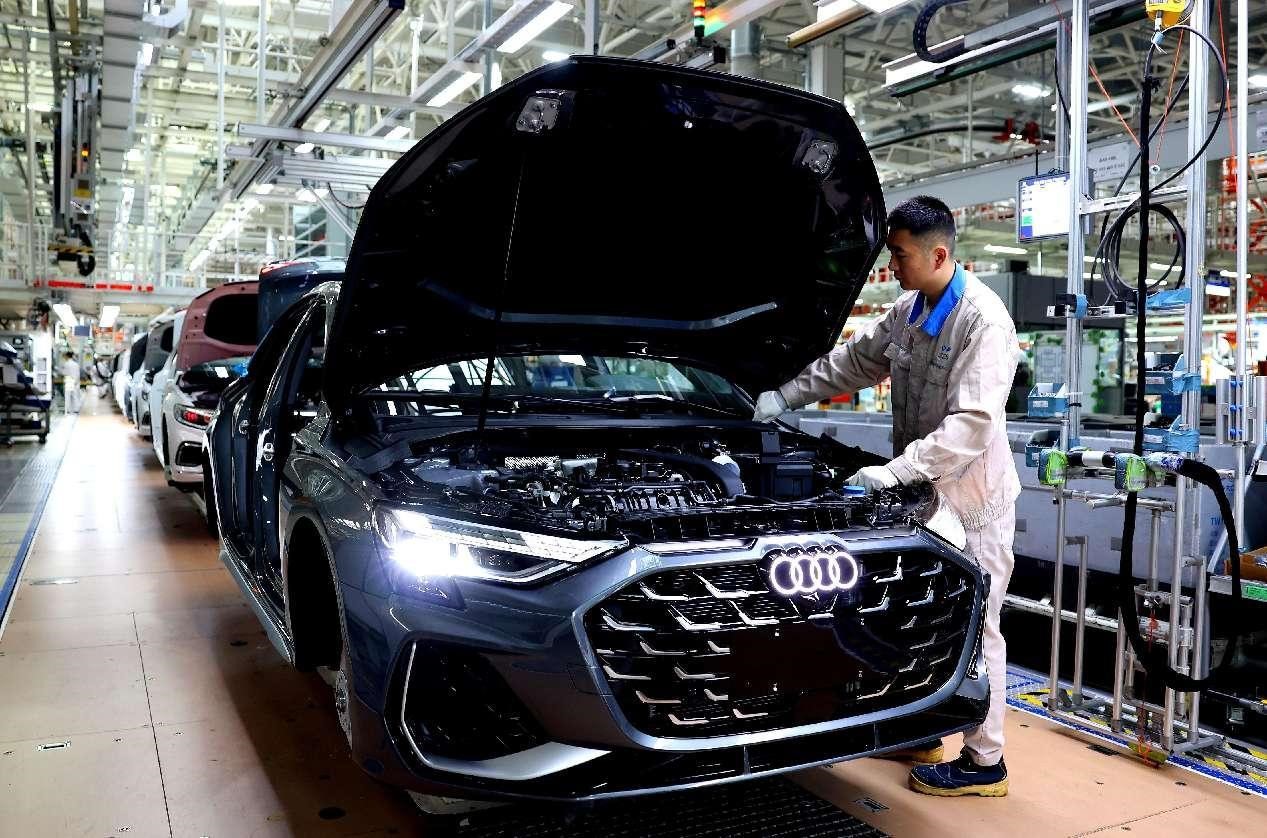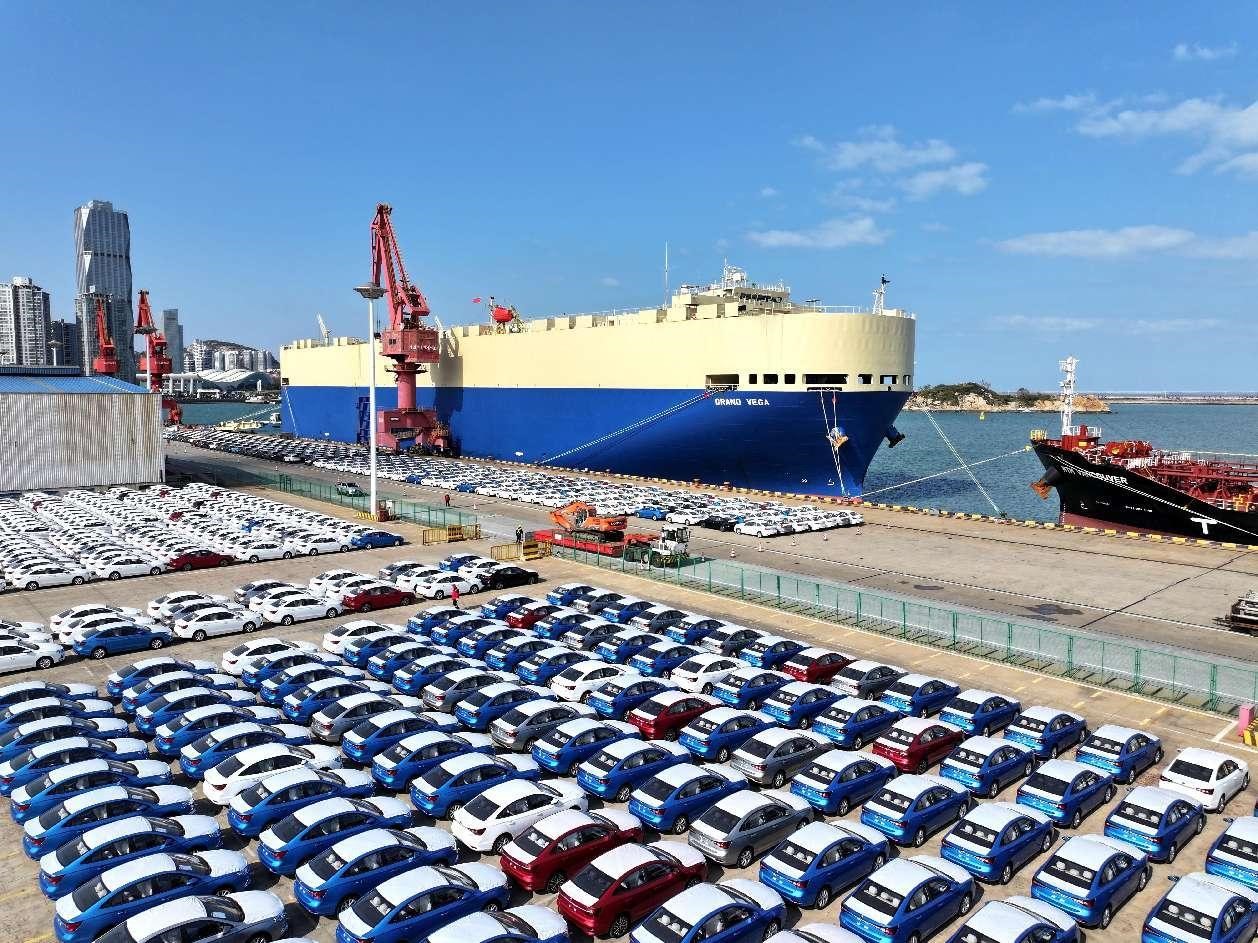To understand China's reform and opening up via two sets of data
Recently, two sets of data highlight the latest achievements of China's reform and opening up.
The first set of data is about China's new energy vehicles (NEVs). On November 14, China's annual production of new energy vehicles surpassed 10 million units for the first time, making China the world's first country to reach this milestone. In the first 10 months of this year, China's NEV exports exceeded 1 million units, hitting 1.058 million units, a year-on-year growth of 6.3 percent.

Vehicles are assembled in a general assembly workshop of FAW-Volkswagen's factory in Qingdao, east China's Shandong province, November 14, 2024. (People's Daily Online/Liang Xiaopeng)
The second set of data involves China-Europe freight train operations. On November 15, the China-Europe freight train service hit the milestone of 100,000 trips. Operating at an essentially balanced schedule of seven outbound trips and six return trips every week, the trains have delivered over 11 million twenty-foot equivalent units (TEUs) of goods, with a total value exceeding $420 billion.
The two sets of data offer a striking perspective into the country's reform and opening-up efforts. Here are three takeaways from this great process.
The first takeaway: Economic globalization has always been the general trend.
On October 11, the 3 millionth vehicle produced by Tesla Gigafactory Shanghai rolled off the assembly line, setting a new milestone. Of the 3 million vehicles, one-third have been exported to Europe and Asia-Pacific countries. In the first three quarters of this year, the Shanghai Gigafactory delivered 676,000 vehicles, accounting for more than half of Tesla's global deliveries during the period.
Tesla's development in China demonstrates the fruitful outcomes of economic globalization and stands as a compelling testament to China's efforts to advance the great endeavor of "harmonious coexistence" among all countries.
Apart from Tesla, a good number of foreign carmakers have ramped up investment in the Chinese market, which underscored that China, with a complete industrial chain, efficient market mechanisms, and a competitive industrial ecosystem, continues to attract global capital to invest and do business.
In April this year, Mercedes-Benz inaugurated a new building in Shanghai as an upgrade to its R&D center in the metropolis to accelerate the innovation efforts in China; Volkswagen committed €2.5 billion to expand its production and innovation hub in Hefei, east China's Anhui province. Since 2010, nearly 100 billion yuan ($13.8 billion) has been invested in the BMW Shenyang Production Base in northeast China's Liaoning province.
The trend toward economic globalization is deepening and countries are increasingly interdependent. No single country can independently manage the entire lifecycle of industrial and supply chains, which involves an interconnected process from R&D to production, distribution, and consumption. Unilateralism and protectionism offer no viable path forward, and "small yard, high fences" will only result in self-imposed constraints.
The second takeaway: Promoting reform through opening up is an inevitable path.
For more than 40 years, China has advanced reform and opening up in a coordinated manner. High-level opening up has become a critical driver for China to promote in-depth reforms and high-quality development.
Since the beginning of this year, China has extended high-level opening-up to broader areas, wider fields and deeper levels.

A fully loaded China-Europe freight train departs from Yiwu West Railway Station in Yiwu, east China's Zhejiang province, for Madrid, Spain, November 18, 2024. (People's Daily Online/Lyu Bin)
On November 1, the new edition of China's national negative list for foreign investment officially came into effect, removing all market access restrictions for foreign investors in the manufacturing sector. On the same day, Chinese authorities released revised rules on foreign investors' strategic investment in listed companies in a move to encourage foreign investors to make long-term and value investment in the country.
On November 22, China announced to apply the visa-free policy to nine more countries on a trial basis. Starting from November 30, ordinary passport holders from 38 countries within its visa-free arrangement, including the newly added nine countries, can enter China visa-free for the purposes of business, tourism, family visits, exchanges and visits and transit, with stays of no more than 30 days.
Additionally, China has introduced a negative list for cross-border trade in services at the national level to boost opening up.
At the same time, deepening reform also provides institutional support for further advancing high-level opening up.
In March this year, China released a guideline to continue optimizing payment services for foreigners and senior citizens in the country. Thanks to the measures, over 5 million inbound visitors used mobile payment in the first half of this year, marking a fourfold year-on-year increase.
China has also rolled out guidelines to speed up the building of a unified national market, regulations on promoting and standardizing cross-border flows of data, regulations for fair competition reviews, and guidelines on improving the market access system.
China has made breakthroughs in key areas and crucial sectors in comprehensively deepening reform, with deep-level reform and high-level opening-up mutually reinforcing each other. This has created new opportunities for economic development.
In July, the 20th Central Committee of the Communist Party of China concluded its third plenary session, and adopted a resolution on further deepening reform comprehensively to advance Chinese modernization. More than 300 important reform measures were introduced at the session, and they will be fully implemented within five years. This will provide not only strong impetus for China's economic and social development, but also more opportunities for global development.

Vehicles to be exported are being loaded onto a ship at a terminal of Lianyungang port, east China's Jiangsu province, November 8, 2024. (People's Daily Online/Wang Chun)
The third takeaway: China's reform and opening up brings opportunities to the world.
China's reform and opening up is a witness to the common progress of China and the world. As China opens its doors wider to the outside world, it is creating significant opportunities for the world.
For instance, the China-Europe freight train service not only allows more countries along the routes to share the dividends of the Chinese market, but also creates new logistics activities, industries, commercial centers and industrial parks, generating numerous local jobs and enhancing connectivity across the Eurasian continent.
"The China-Europe freight train service meets the needs of businesses exploring European and Asian markets, bringing brand-new development opportunities," head of a logistics company in the Netherlands said.
The recently concluded seventh China International Import Expo (CIIE) saw $80.01 billion worth of tentative deals reached for one-year purchases of goods and services, an increase of 2 percent over the previous year, demonstrating the vast opportunities of the Chinese market.
Openness is an intrinsic path toward global prosperity and development. In addition to the CIIE, China is also hosting other global trade fairs one after another, including the Canton Fair and the China International Fair for Trade in Services (CIFTIS).
Through the new development, China is creating fresh opportunities for the world, promoting the building of an open world economy, and writing a new chapter of shared development between China and the world.
Photos
Related Stories
- China to develop new institutions for higher-standard open economy
- China embraces world economy with unswerving opening-up
- China's wider opening-up brings tangible benefits to world
- China further expands development space through institutional opening up
- China remains committed to path of pursuing common development through opening up
Copyright © 2024 People's Daily Online. All Rights Reserved.









